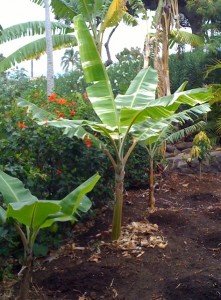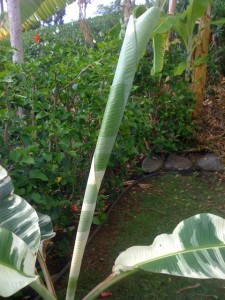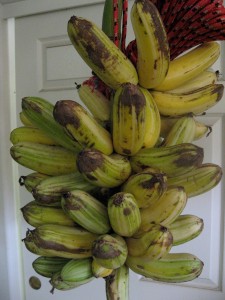I first heard about variegated bananas from arborist Arlene Salomon. She raved about how lovely one would look in my garden, told me that it originated in Hawai’i and was considered sacred by Hawaiian royalty, and how even the bananas themselves were variegated. Finally I saw one at the Maui Nui Botanical Gardens in Kahului, and was smitten. I heard that they were occasionally for sale at the garden’s bi-annual plant sales, so when the next one came around, I showed up early to claim my prize.
The garden had several bananas for sale that day, most of them for $15 or $20. I was shocked to see that the price tag on the lonely variegated banana had an extra zero on the end. That’s right, $200! I would have walked away had I not told my husband and several friends that I dragged to the sale that I was going to get that banana. Peer pressure was applied and I found myself lugging a hefty green-and-white banana across the garden to my car. Luckily, when my mother heard of my buyer’s remorse the following day, she took the sting out of my indulgence by making it my Christmas gift.
And what a gift. The variegated banana, Musa ‘A‘ea‘e’ (Hawaiian for “hair prematurely graying”) or ‘Manini’ has extraordinary green-and-white mottled leaves and a variegated stalk. I watched from my bedroom window as it often grew new leaves at the rate of a foot or more a day. Within three months it went from six feet to twenty feet. I felt like I had planted Jack’s Beanstalk in my backyard.
Given how fast it grew (a vitality unusual in variegated plants, which tend to be weakened by the virus that makes them variegated), I expected to see the flower and fruit in quick order. But while other bananas we had planted quickly produced flowers, the variegated banana took its sweet time. Richard Stevens writes in his lovely book, Tropical Organic Gardening: Hawaiian Style that bananas are “good at teaching us patience and the reward that comes at the end.”
That was certainly true in our case. My husband, Doug, who doesn’t normally get interested in plants, followed the development of the bananas closely, but lost interest as the weeks stretched into months. Then one day he came running in, excited, and dragged me out to see that the bananas were ready for harvesting. One single banana had started to turn from white-and-green variegated into yellow-and-green variegated. But we had learned from our other bananas that the first yellow banana is like a neon signal to the local birds and beasts, saying “Eat here now.” So we hacked down the bananas and carted our treasure safely into the garage, where they could finish ripening in peace.
The variegated banana lacks the crisp taste of the Apple Banana and has a slicker texture than the Williams banana (which you generally find in the store). But it can be eaten fresh, cooked in a little butter, or — my favorite — frozen and used in smoothies.
As a final gift, I have four keiki (babies) popping up around the old base, and I’m hoping to recoup my mother’s investment by selling a couple on Craigslist.
[If you’re interested in growing unusual bananas, see this article from the folks at Pacific Islands Agroforestry.]



Comments on this entry are closed.